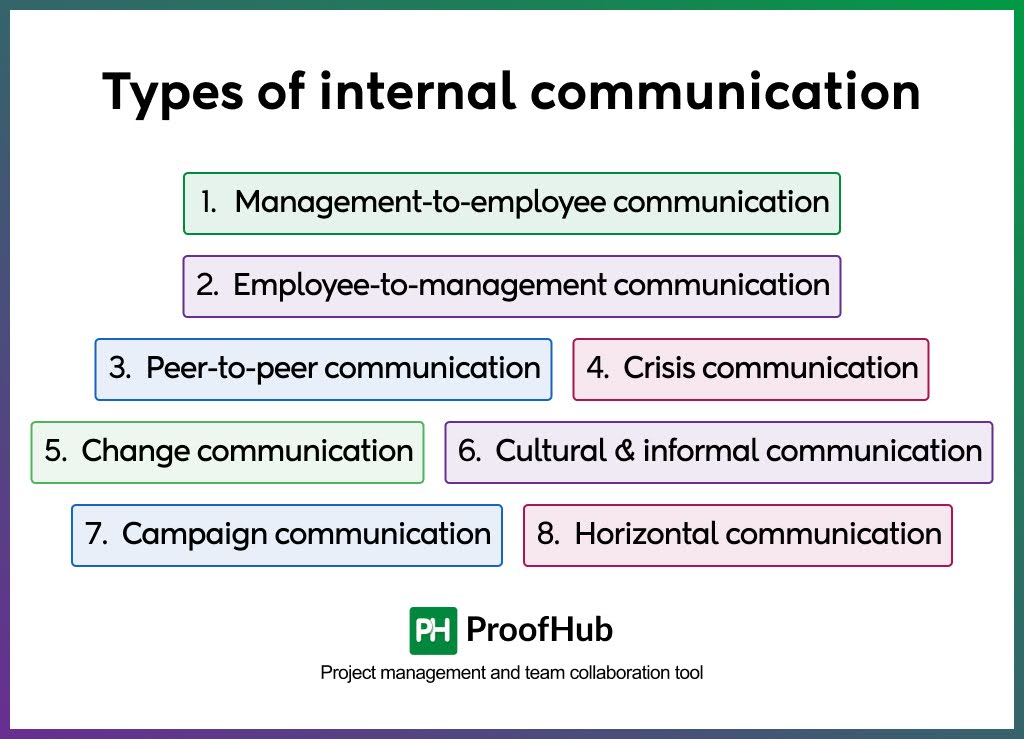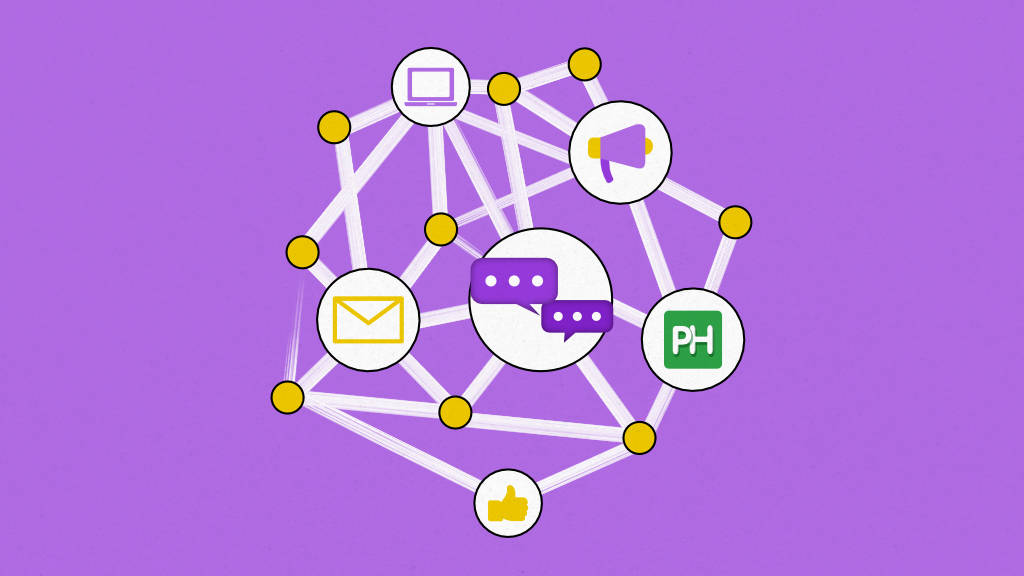Introduction
Internal communication is the backbone of any successful business. It ensures that everyone is aligned with the business goals, informed about priorities, and empowered to contribute their best. Whenever we talk about business communication, everyone starts advocating for the importance of interaction with external stakeholders. Company-wide interaction and different types of internal communication are often overlooked.
It is imperative to communicate with all your external stakeholders efficiently as they play a significant role in growing your business. But let’s not forget about the internal aspects as communication is not limited to a business and its customers only.
Having effective communication with your internal stakeholders is just as important or, I should say, more important than any other form of communication because it’s them who shape your business and help you sustain it in the long run.
Effective internal communication is all about passing the word to your employees in a way that keeps them interested, involved, and invested in their work.
What is internal communication?
The exchange of information, ideas, documents, and messages within an organization between employees, departments, and management refers to internal communication.
Internal communication can be done through face-to-face interactions, emails, phone calls, meetings, or a collaboration platform. It plays a vital role in communicating important updates, sharing knowledge, coordinating tasks, and team building in the workplace.
What are the different types of internal communication?
There are many types of internal communication and you can use different structure of communication according to the needs of your organization.
Because no two businesses are alike, different internal communication methods may be effective in different situations. Mentioned below is a list of different kinds of internal communication used by the businesses.
- Management-to-employee communication
- Employee-to-management communication
- Peer-to-peer communication
- Crisis communication
- Change communication
- Cultural and informal communication
- Campaign communication
- Horizontal communication
There are so many other types of communication, however, we will discuss the top eight as these are the most important and widely used communication types that you can use in your organization.

1. Management to employee communication (Top-down)
Management to employee communication is one of the most important types of internal communication that focuses on organizational structure and the systemic delivery of information from the highest levels to the company’s employees.
Top-down communication is a hierarchical method of sharing information and instructions inside a company. Each level in the hierarchy passes information from the level above until it finally reaches everyone in the company.
This type of internal communication ensures that everyone has the necessary information and details to complete relevant tasks or activities. It also improves how information is shared within the company.
It ensures that every employee is properly informed about all organizational and legal procedures of the company.
Effective employee communication management brings in employee alignment and keeps everyone focused on the same goals and objectives.
Not just that, it helps you build better connections with your workforce because employees are more loyal and productive if you keep them informed about everything.
How to ace it?
- Be transparent
An organization must make sure that its communication process is transparent and straightforward. No secrets. Employees like to know things. Nobody can work in an environment where they are surrounded by secrets and hidden information.
- Build in accountability
If you have a message that needs to be relayed throughout the organization, assign your subordinates a deadline and hold them accountable for it. Also, make sure to check with employees at all levels to confirm whether the information was received.
- Use multiple means of communication
Different types of internal communication require different mediums or tools. Emails, texts, meetings, communication, and collaboration tools all have their own place. For example, a face-to-face or virtual meeting would be the best way to convey strategic information, while using an internal communication tool would be ideal for everyday follow-ups or quick discussions. Utilizing an internal communication tool like ProofHub can help you manage company-wide and team communication effectively.
- Tailor your communication
You need to ensure that your message is relevant to the audience you’re talking to. Not all of your employees need to know every little detail of your organizational strategy or any new initiatives. Consider who you’re talking to if the information is relevant, and tailor your message accordingly.
2. Employee-up communication (bottom-up)
Employee-up communication is another significant type of internal communication that starts from the bottom of an organization and makes its way to the highest positions. It is an upward communication process that enables employees to pass on critical information and feedback to the upper management.
Bottom-up communication revolves around the inclusion of the entire workforce, their ideas, and their personal and professional experiences to build a positive company culture.
Businesses need to understand that an organization’s information flow should never be one-sided. Two-way and bottom-up communication processes help you create an atmosphere where employees feel valued.
How to ace it?
- Be approachable
Being a leader, you must be approachable, otherwise, your employees will never be able to open up to you. It is believed that when you put your employees at ease and let them be comfortable, they trust you more and perform better under your leadership.
- Acknowledge two-way feedback
Two-way feedback can help employees and the organization gets better at what they do. It is vital to give feedback to your workforce regularly but asking for their feedback is just as important. Two-way feedback helps your employees to perform better and lets an organization develop a better work environment.
- Have an open-door policy
An open-door policy is a workplace standard that allows employees to talk to senior management or their immediate supervisors about any topic at any point in time. This policy aims to promote open communication, two-way feedback, and discussions regarding any issues faced by employees.
- Provide effective internal communication channels
Providing the proper communication channels to your employees is the key to building an efficient internal communication process. It keeps your employees engaged and aligned with your business objectives. Using an internal communication tool will help you connect with all the employees in your company effortlessly.
3. Peer-to-peer communication
Peer-to-peer communication refers to communication between individuals at the same level within the organization, often among colleagues or team members who work on similar tasks or roles. This communication focuses on collaboration and information sharing among employees without involving a managerial chain.
Peer-to-peer communication plays an important role in creating a collaborative work environment and maintaining the smooth functioning of daily operations within an organization. This type of communication encourages teamwork, improves problem-solving, and accelerates decision-making.
How to ace it?
- Practice positive communication
Positive communication means relaying your message thoughtfully and tactfully. It also involves praises and acknowledgments. Make sure that you have positive communication with your employees regularly as it would encourage them to do the same with their peers.
- Let your employees decide the communication pattern
Everybody in the world has their communication style. Allow your employees to express how they wish to be communicated with. While some of your employees might like things to be a little casual and informal; whereas others might want everything to be super professional and formal. Encourage your employees to get to know each other better and practice positive communication in the workplace.
- Fix and tend to issues immediately
No matter how hard you try, there will be times when you and your employees will face challenges with your communication process. It could be anything from a technological issue to a heated-up argument between two of your employees. Instead of ignoring the problem, try having an open conversation and fix it right away. Keep in mind that peer relationships can make or break the organization as a whole.
4. Crisis communication
Crisis communication is one of the most critical types of internal communication. It refers to the processes, strategies, and systems that help an organization communicate effectively during a crisis.
As we know a crisis never occurs with a warning. Thus, it is never more critical than in a crisis to get the appropriate information to the right individuals in a fast, efficient, and effective manner.
The perfect example of a crisis would be the pandemic. Nobody was prepared for it. The world turned upside down in no time, especially the businesses.
It was nothing but a lesson for us to be prepared ahead of time for a crisis to ensure that everyone in the organization can effectively communicate with each other to quickly alleviate the situation and ensure business continuity without any hassle.
How to ace it?
- Make a solid crisis communication plan
Just like any other business strategy, crisis management, and communication also needs a proper plan and objectives. Without an appropriate plan, your employees are less likely to get aligned with the company strategy. Having a crisis communication plan ready beforehand assures a systematic flow of information, decreases misinformation, and keeps everyone on the same page.
To make a solid crisis communication plan, you need to make sure that-
- Communication takes place in real time.
- Information is accessible from anywhere.
- Messages are relevant to the intended audience.
- You train your employees to develop good communication skills.
- Your statements are simple, accurate, and consistent.
- Perform “what if” exercises and ask for employee feedback.
- You create appendices and guidelines.
- Use the right technology
Businesses need to understand that crisis communication can never be successful if you do not use the correct technology for it. Internal communication tools are one of the most significant considerations for this type of communication. They provide you with effective solutions for real-time and unified communication within your organization.
An internal communication tool like ProofHub is communication-effective, not only in terms of chats, discussions, and recording minutes of meetings but also through visualization of tasks and tracking all moving progress.
Organize your business communications and management using ProofHub. One tool for all professionals.
- Conduct post-crisis analysis
Once the crisis is over, employers must address a few questions like:
“What did we learn from this crisis?”
“What went wrong?”
“Did we have a crisis plan in place?”
“How can we enhance our crisis communication in the future?”
Even though these situations are uncomfortable for anyone, they should serve as a valuable lesson and learning experience for your business. Perform post-crisis analysis and ask for employee feedback to be better prepared for such unprecedented situations.
5. Change communication
Change communication refers to sharing information and updates about organizational changes with employees. This involves explaining why changes are happening, what they will affect, and helping people adjust to ensure they understand, accept, and support the changes.
It gives stakeholders a better grasp of the new initiatives and assists them in moving from where they are now to where the organization wants them to be in the future.
Whether you’re making changes with the technology, work practices, company rules and guidelines, leadership styles, or a combination of different things, an effective change communication process is crucial to ensure a smooth transition.
How to ace it?
- Analyze change impact
Before anybody else, it’s the management that needs to be well aware of changes coming up. It is essential for you to thoroughly understand and examine the factors that are supposed to change, who will be affected by them, your desired goals, and how you plan to achieve them. Develop a clear vision of the future, and then start communicating your plans to your team.
- Develop a change management strategy
A change management strategy in business defines how an organization will deal with the upcoming changes in the future. It is a blueprint that addresses topics and approaches related to resources, communication, learning, participation, sustainability, engagement, and change adaptability.
- Run internal communication campaigns
A communication campaign is a drive that uses media, technology, messaging, and a specific set of communication activities to achieve particular results for a large number of individuals in a specified time-frame. Once you have analyzed everything and formulated a change management strategy, it’s time to execute your plans by driving action and influencing change all across the organization. Running internal awareness campaigns is a great way to do so.
6. Culture communication
Cultural communication can be defined as the way your organization communicates with its employees, disseminates information, encourages them to speak up, and keeps them engaged.
If you wish to increase your employees’ performance, motivation, engagement, productivity, experience, and overall business growth, this is one of the most significant types of internal communication that should be practiced in your organization.
Everything from attracting top talent, retaining employees, branding, and business stability to employee performance is influenced by company culture. Consistent internal communication is the key to building a positive company culture.
Cultural communication covers everything from company mission, values, initiatives, policies, rewards, recognition, social events, and non-business information to on-boarding communication.
How to ace it?
- Maintain professionalism in a casual way
When it comes to creating a positive communication culture, the tone of voice is key. It is crucial to find the perfect balance between the corporate and casual culture. Nobody likes to work in an environment where everything is super formal. Offices have become significantly more casual over the past few years. You need to provide your employees with a comfortable environment to work in and make sure that your workforce stays aligned with the company’s rules and regulations.
- Eliminate one-way communication
Gone are the days when employers would issue a company-wide newsletter to inform their employees about a specific topic. This way, employees are unable to express themselves and raise their issues due to one-way communication. It prevents them from being a part of company conversations and feeling more engaged. According to a recent report, employees are 4.6% more empowered to do their best work if they feel their voice is heard in the workplace.
7. Campaign communication
Campaign communication is an important part of running successful campaigns. This helps teams understand the campaign’s purpose, goals, and the actions they want to take.
It bridges the gap between the campaign’s objectives and its execution, aligning and motivating participants to contribute effectively.
An effective campaign communication strategy is important for achieving your desired outcomes, whether your campaign focuses on marketing, awareness, product launches, or internal initiatives.
How to ace it?
- Define campaign objectives
Before launching a campaign, determining its objectives and purpose is essential. This clarity will help you to create a focused and impactful communication plan.
- Create a campaign communication plan
A campaign communication plan describes the methods, channels, and tactics you will use to deliver messages. For greatest impact and reach, it incorporates essential elements such as messaging tone, timing, frequency, and formats.
- Use centralized communication
Use a centralized communication tool like ProofHub to make your campaign communication smooth and effective. This ensures that everyone associated with the campaign hears your message, strengthening the campaign’s objectives and driving engagement.
- Track and refine communication efforts
It’s important to track how good your communication plan is working. To determine whether your messages are resonating with the audience, use analytics tools and get feedback. To make clarity, engagement, and alignment with marketing objectives, modify your strategy as needed.
8. Horizontal communication
Horizontal communication refers to communication across different departments, teams, or units at the same hierarchical level. This is a way to share information, coordinate efforts, and collaborate between groups working towards a common organizational goal. It creates an atmosphere of collaboration by making it easier for departments or units to collaborate, coordinate, and solve problems.
This type of communication encourages a culture of transparency and teamwork, where people can share ideas, insights, and updates effectively.
Whether it’s sharing project updates, coordinating between departments, or brainstorming new ideas, effective horizontal communication is essential to maintaining efficiency and alignment across the organization.
How to ace it?
- Promote cross-departmental collaboration
Provide opportunities for teams to communicate and exchange information. Promote open discussions during meetings, collaborative workshops, or through shared digital tools that allow for seamless communication across teams.
- Use collaborative tools
Use platforms like team chat applications, project management tools, and shared workspaces for communication. These tools make sure that employees can exchange information easily, track updates, and resolve issues in real-time.
- Create a culture of transparency
Create an environment where employees can discuss their problems and insights. You can achieve this by setting clear expectations, recognizing collaborative efforts, and providing feedback channels where individuals can voice concerns or suggestions.
- Provide training for effective communication
Provide training sessions or seminars to enhance teamwork and relationship building abilities. To make horizontal communication effective and in line with corporate objectives, concentrate on active listening, dispute resolution, and message clarity.
Conclusion
Effective and efficient internal communication ensures that everyone in the organization aligns with the same goal and works in the same direction to achieve it.
By choosing the right communication methods according to your organization’s needs, you can create a strong, coherent culture that helps employees make better decisions aligned with company goals. This leads to improved efficiency, higher productivity, and better customer service, driving long-term success.

